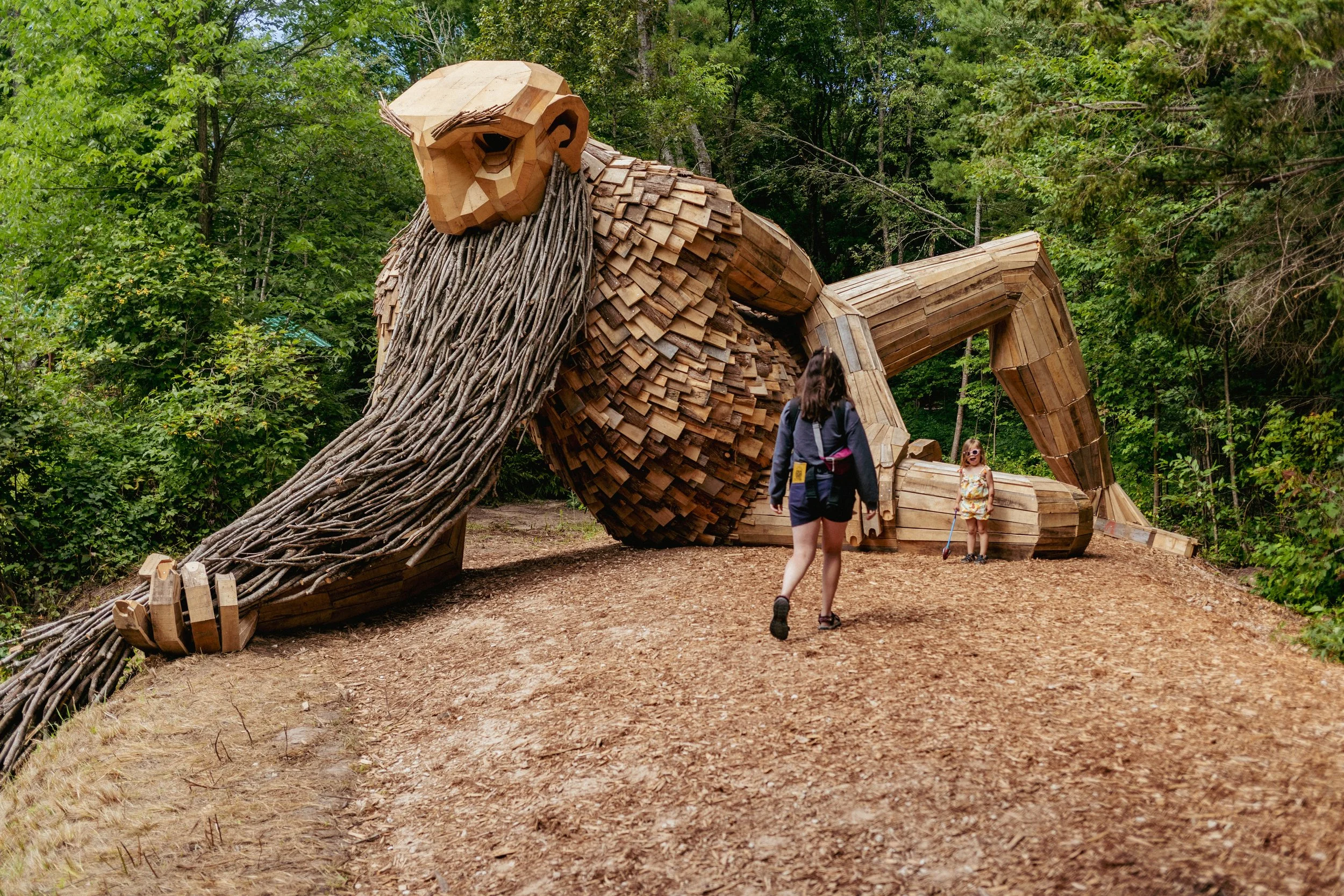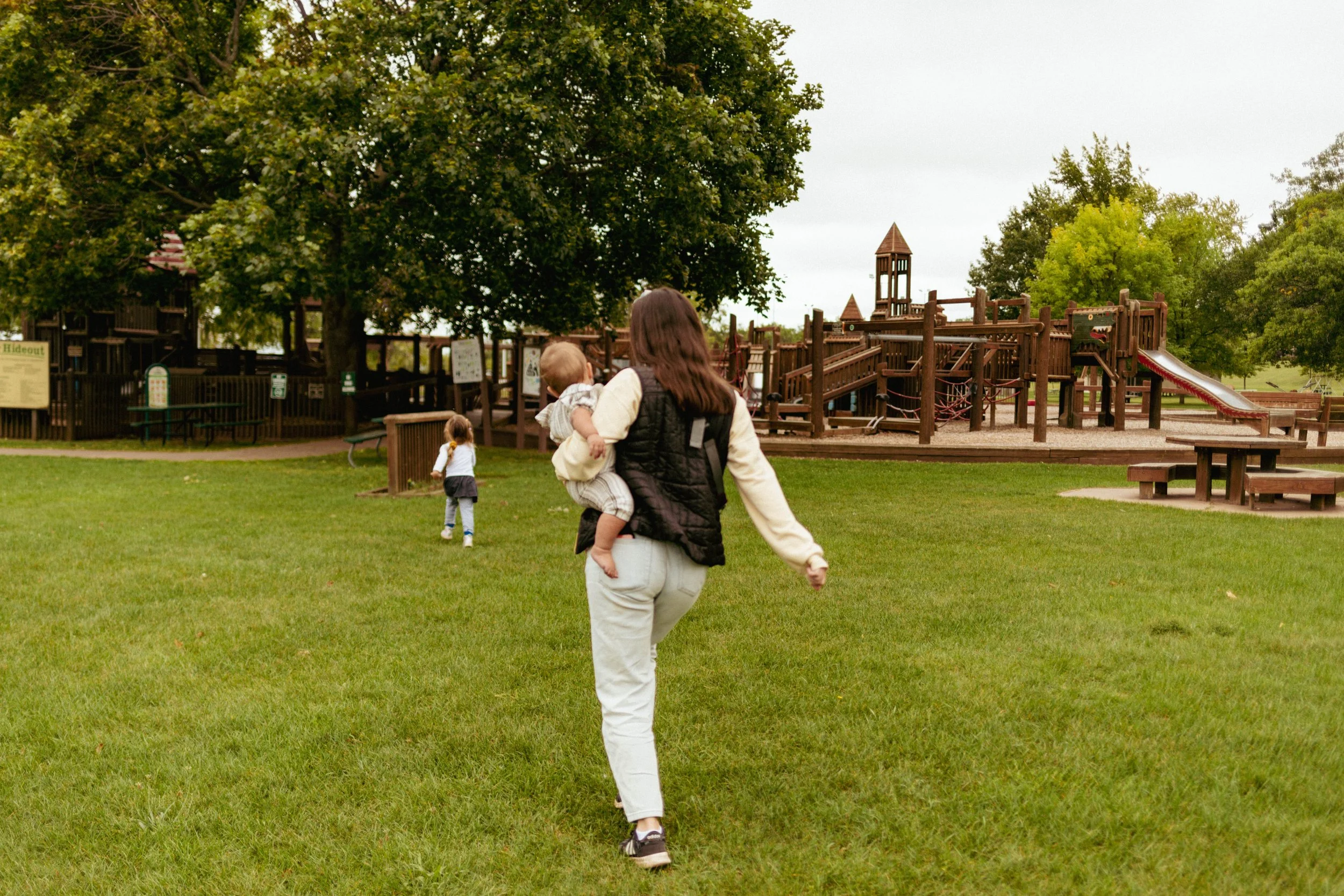Creating a Balance: Tips to Succeed the 1000 Hours Outside Challenge
The 1000 Hours Outside challenge, started by founder Ginny Yurich, was not meant to have a cut-and-dry way to completion. There are so many nuances, variables, and ways to achieve its goal. The challenge itself was just created as a way to get families back to the simple joys of nature. After a few years of participation in the 1000 Hours Outside Challenge, I have seen this question many times in the forum. I have created this ultimate guide as a one-stop-shop to (hopefully) answer all those questions! These tips will be based on things I, as a mom to two young children, have learned and have organized in a way to help you achieve more time outside!
If I you don’t see the answer to your question here, leave it in the comments below! I’ll answer as best as I can.
Why 1000 hours outside
Visiting Benny the Beardfisher in Germfask Michigan.
The 1000 Hours Outside challenge offers numerous benefits for individuals and families. Spending time outdoors has been linked to improved physical health through increased activity levels and exposure to natural sunlight, which can boost Vitamin D levels. The outside world provides all the necessary sensory input for growing children. Additionally, being outside can enhance mental well-being by reducing stress, anxiety, and symptoms of depression. Engaging with nature fosters a sense of wonder and curiosity, promoting creativity and cognitive development. The challenge also encourages families to bond over shared outdoor experiences, creating lasting memories and strengthening relationships. Overall, the 1000 Hours Outside challenge serves as a valuable tool for promoting holistic well-being and connection to the natural world.
“Whatever shape nature takes, it offers each child an older, larger world separate from parents. Unlike television, nature does not steal time; it amplifies it.”
-Richard Louv, The Last Child in the Woods
Educators and children’s specialists have all brought up the benefit of unstructured play outside. British educator Charlotte Mason suggested 4-6 hours outside every “tolerably fine day, from April till October”. Pediatric occupational therapist Angela Hanscom states kids of all ages should be outside for at least three hours of free play each day. The Nordic countries are always winning when it comes to happiness. How? Well, one of the contributing factors is that they believe in a concept called ‘frilutfsliv’, or a simple life in nature. A childhood (and adulthood) that is spent surrounded by nature is just backed by data!
Setting yourself up for success
Stopping along Lake Michigan during one of our road trips!
To set yourself up for success in the 1000 Hours Outside challenge, start by creating a clear plan that outlines how you will spend your time outdoors and your reasons for spending time outside. Consider scheduling regular outdoor activities such as hiking, biking, gardening, or simply taking a daily walk. There are so many wonderful activities to be experienced! But, don’t forget to schedule downtime too. Include time to just sit on a picnic blanket at watch the clouds.
Set achievable goals each week to track your progress and stay motivated. If this is your first time attempting the challenge, give yourself grace and start small. We ‘failed’ our first year with only achieving 800 hours. But you know what? We learned so many valuable things from it too! Want to read more about our failure? I wrote What I Learned From Failing The 1000 Hours Outside Challenge so you could learn from our mistakes too!
If you are especially not outdoorsy, start by finding all of your favorite things and doing them outside. I suggest beginning with small increments of time outside and slowly adding time each day. Think about it this way - when you exercise, do you attempt to do it all in one day? Of course not! That would cause more harm than good, and increase burnout. You would probably start with gentle cardio the first day to build endurance. Then maybe you would work on arms the next day. Finally, working legs. Then, most importantly, you would have a rest day. It’s the same thing for outside! Don’t plan a 3 mile hike if you can only walk for 15 minutes. And plan rest days, maybe in a hammock or cozy spot!
Make sure to prepare adequately by checking the weather forecast, dressing appropriately, and bringing necessary supplies like water, sunscreen, and snacks.
Find a support system, whether it's joining a community group or involving your friends and family in the challenge. Find and join the 1000 Hours Outside official Facebook group. Then, see if you have a local chapter Facebook group. From there, you can ask if anyone has any nature meetups, forest schools, hiking groups, gardening clubs, etc. that you can attend. Being surrounded by people with the same goals will help you turn this challenge into a lifestyle!
Remember, consistency is key, so stay committed and embrace the benefits that spending time in nature can bring to your health and overall well-being.
Household duties
We loved this playground in Escanaba!
This will definitely vary with your stage of life. My household duties are going to be tailored towards having young children and prioritizing making memories rather than the endless tasks of the house. More interested in how we spend less time cleaning and more time connecting? You can read my full article: here!
Daily
Each day, my motto is “don’t set it down, put it away.” This can be applied to ANYTHING. Cooking food? Don’t set the dirty dishes down, put them in the dishwasher (or wash them and leave them to dry). Bringing toys back inside? Don’t set them down, take them to the play space and put them away. Bringing in a bag from the day of exploring? Don’t just leave it on your shoe bench, empty it and put it away. Keeping up on these daily tasks will help minimizing cleaning in the long run. This is actually a tip I took away from Marie Kondo’s The Life-Changing Magic of Tidying Up.
Use a caddy or basket! The constant running in and out all day is sure to make you want to pull your hair out. I make sure we grab everything we may need, throw it all in a basket, and bring it out. One simple trip out, and one easy trip back in! Of course we still have to run in to make meals, or to swap out toys, but having a caddy helps minimize all the trips in between. But as the family begins to get in the habit of going outside, you’ll find it is surprisingly easy to stay outside for hours on end. Nature will begin to occupy children in a variety of ways, they will get creative and use what is around them.
The biggest housework tip I can leave you with, though, is to close down your house daily. If you aren’t familiar with the concept of closing down your house, just think of a restaurant worker. At the end of their shift, they have to run through a list of daily tasks, wipe down counters, restock and make sure the shop is in top shape for the next day. Once we started closing down our house at the end of the night, we noticed a dramatic shift in our day-to-day. We no longer had to worry about jumping straight into chores the next morning! We could enjoy a slow morning with a cup of coffee, and watching our kids enjoy their morning play routine. I go through all of our steps to closing down our house in my article: Spend Less Time Cleaning and More Time Connecting.
The second biggest tip I can leave you with is to let it go. Housework is never ending; childhood is not. Your house may just stay cleaner if you are out of it all day! When the kids are all grown up, there will be plenty of time to clean.
Weekly
I have been working on building the perfect weekly schedule for us. It’s not complete, but we are getting there! I prioritize the big tasks that I know we need to do each week in case we have any drop in visitors, or just to keep our house healthy and happy. Any time I bring out my steam mop, I go ahead at steam all top touched spots in the house (hand rails, door knobs, light switches, etc.). Steaming these spots weekly will help disinfect and reduce sick days. So here is our current weekly schedule:
Sunday: Groceries + Clean Fridge
Monday: Dusting
Tuesday: Kitchen wipe down! Vacuum floor and steam mop all appliances + floor
Wednesday: Nature group day - rest day or left over day!
Thursday: Bathrooms
Friday: All Laundry
Saturday: Rest Day
Things to do outdoors
One of my kids at 5 months old watching her older sister play outside while I painted.
Now that you have a goal and you have an idea of a schedule, it’s time to think about what to do! Honestly, the possibilities are endless. If you need more ideas, simply Google “what to do outside” and you can find anything! I’m just going to list our top favorites.
Camping
Hike/walk
Stargazing
Gardening
Swimming
Have a picnic / tea party
Bird watching
Yoga
Paint
Bike
Skating
Dance
Snowshoeing
Sledding
Playdough
Foraging/u-pick farms
Take your meals outside
Board/card games
Need more structure? Find your local gardens/parks! Volunteer in local outdoor organizations. Ask your friends to do your weekly meetup at a park, trail, or outdoor eatery.
What kind of hours count?
This is such a personal question! But my favorite answer that has been given yet is ‘can you be eaten by a bear? Then it counts’. Weirdly morbid, but I find it hilarious! If you are in plain air, I count it all.
All in all, take the time to slow down. Childhood shouldn’t be spent being busy running from one activity to the next, but exploring. There is so much to learn from nature if we just take the time to do it. Learn about gravity by skipping stone on the water. Enjoy botany by visiting gardens or the woods and taking a look at the plants growing. Nature holds the key to education on so many more levels than we often even consider. Don’t take it too seriously. This challenge wasn’t created to stress you out - in fact quite the opposite. It was meant to help us learn peaceful parenthood, to slow down, and to enjoy the journey.
I hope this helped a little. I’m always updating my articles as I come across new information, update my schedules, or figure out new ‘life hacks’. So if you have anymore questions, leave it in the comments below so I can know what I’m missing!
Or
Do you have a favorite tip that helps you complete the 1000 Hours Outside Challenge? Leave it below!
Let’s help build a community of outdoorsy folk one tip, one trip, and one hobby at a time.




